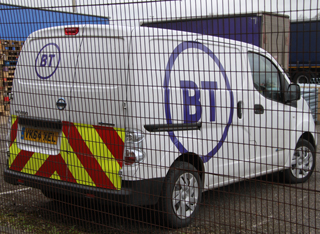A Detailed History
 |
The ubiquitous Vauxhall Vivaro is a mainstay of the BT Fleet, although the majority of new vans are badged within the network access of Openreach. |
The BT Fleet periodically changes its vehicle livery to reflect the current company profile and branding. A major change was from a grey to white base colour, and in recent years the use of multi-coloured vinyls (e.g. the London 2012 Olympics branding) have produced eye-catching displays. Vehicles and branding will continue to evolve and these pages aim to track the ongoing developments...
| The Grey Fleet | |
 |
"BT’s piper is a living message carrier or communicator with a very real human purpose. The symbol has a hint of heraldry which gives it nobility and a sense of history." |
| The White Fleet (Piper) | |
 |
"The logo's background will be changed from grey to white "to show off the trumpeting figure more effectively." |
| The White Fleet (Global) | |
 |
The BT Openworld, 'Connected-World' logo was introduced in April 2003 as part of BT's new corporate image. |
| The Purple Fleet | |
 |
The rather distinctive use of purple as a BT identity together with a vinyl-wrapped family scene and strapline 'Get in touch.' |
| The Circle Fleet | |
 |
The simplified BT branding using the new 'circle' logo. |
The New Roads & Street Works Act 1991
As a result of various provisions [dated 28.11.92, 01.01.93 & 01.04.93] of the above code, all vehicles working on or beside roads had to be fitted with a amber rotating roof beacon. Thus the majority of BT vans have beacons fitted as a matter of course. In the 2010s, some roof racks incorporate 4 orange flashing lights, in lieu of the usual single rotating beacon.
WITHOD
Working In The Hours Of Darkness is an initiative which was trialled during July 1994 and rolled out later in the year. Essentially it was a portable lighting kit to enable field service technicians to work safely in conditions of 'poor natural light.' It was intended to extend the working day, in order to maximise efficiency and to allow provision and repair of customers' overhead lines outside of normal hours.
All logos and trade marks are the property of their respective owners and are used on the Light Straw site(s) for review only. Students and researchers are recommended to make their own independent enquiries as to the accuracy of the information contained therein.